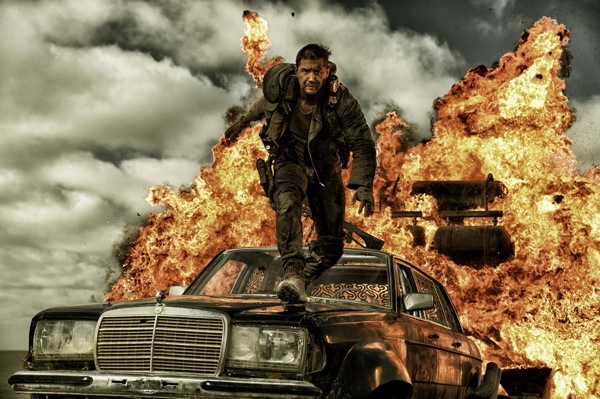
After attending an afternoon showing of Mad Max Fury Road, I stood outside the theater in a daze. I was almost literally speechless, and my PTSD continued as I hopped in a cab to go to a dinner engagement. Fury Road’s insane, relentless, vivid and non-stop car chase was so senses shattering that it felt weird to actually BE in a car in the real world. I kept expecting the taxi to rear end a war rig or see an Interceptor career towards us at a 45 degree angle or have a Polecat suddenly dip towards our cab, lobbing a grenade. The real world suddenly seemed like a distant echo of the thunderous one that had seared itself on my eyeballs for the last 120 minutes.
My visceral reaction was so different from how I felt after any number of recent CGI extravaganzas. I’d forgotten about Age of Ultron by the time I crossed the street. I left Guardians of the Galaxy humming “Ain’t no Mountain High Enough” and loving raccoons, but the plot quickly receded into the rearview mirror. Perhaps this is because of my own subconscious processing of real images as opposed to animated ones — the practical effects of Fury Road are so much more memorable and powerful—and expensive.
I can’t remember the last time an action movie seized the imaginations of critics and viewers alike so fully. MMFR’s stunning 98% rating on Rotten Tomatoes make all the recent Best Picture nominees look shabby. Most people I know had a similar road to damascus experience, with multiple viewings planned. They’ve heard the call and have to keep preaching. I kept calling Avengers: Age of Ultron an “experience” not a movie, but Mad Max Fury Road was the real experience, something so exhilarating and cathartic that people need to feel that way again.
It would be simple to declare that the success of Mad Max Fury Road is just due to good old fashioned great moviemaking—and it’s true. George Miller is an amazing filmmaker, always has been, Babe: Pig in the City. But it’s 2015 and this is the internet, so let’s drill down with some crucial questions, shall we?

Is Mad Max Fury Road a success at the Box Office?
Maybe the MRA/GuffleGab crowd—which suggested a boycott of MMFR due to its feminazi lies—is crowing about the film not hitting #1 at the BO, proving people don’t want to see a movie with a strong female lead, but it was beaten by Pitch Perfect 2, a girl-aimed movie about an all girl singing contest with a mostly girl cast, a first time female director—congrats Elizabeth Banks!—and a 75% female audience. MMFR had a 60% male audience. This was a pretty straightforward win for girl power—$70 mil to $44.4 mil. All this led Pitch Perfect producer Lynda Obst to crow a bit:
64m weekend for Pitch Perfect 2 beats MadMax!! Here come the Girls;the Frozen Generation to take over the box office! Watch out Caped Heroes
— Lynda Obst (@LyndaObst) May 16, 2015
It also explains why that awful Jem and the Holograms trailer has a title that reads “From the studio that brought your PItch Perfect.” We have a new tentpole here, and people are going to be chasing it for a while.
Deadline’s Anita Busch put an even gloomier spin on it:
This $200M+ budgeted road rager from Village Roadshow was definitely restricted by its R-rating but there’s no pr company in the world that can put a great spin on this opening weekend. Everyone wanted this one to open better.
Mad Max triumphed worldwide with $109.4 mil, which sounds pretty good until you remember that this movie cost $200 million. All those Cirque du Soleil stunts and practical effects did not come cheaply, oh no. I’ll get back to that in a minute. As you probably know, MMFR had a very troubled production, with fits and starts for 15 years, and a worried set visit by WB’s Denise De Novi to find out what was costing so much and why Tom Hardy and Cherlize Theron didn’t get along. While there’s already hopeful talk of a sequel, to be called Mad Max: The Wasteland, this is not a no-brainer. In fact, it’s a total brainer, so we’ll have to wait and see. In the meantime, Miller and Co have turned to the far more economical world of comics to tell more of the backstory. Smart move, Vertigo!
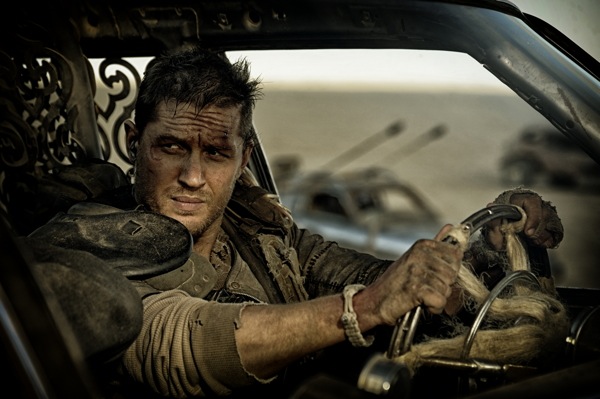
Is Tom Hardy as Mad Max awesome possum?
Yes.
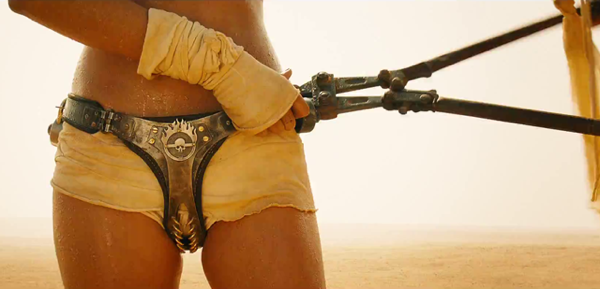
Is Mad Max Fury Road a feminist triumph?
1) On first thought, as everyone now knows, George Miller intended this to be explicitly feminist in its message, and even got playwright/activist Eve Ensler (The Vagina Monologues) on set as a consultant. And looking at the story of Imperator Furiosa (Cherlize Theron) seeking redemption by rescuing the five wives (who had already graffiti’d up their living quarters with empowering slogans) of the grotesque Immortan Joe with the aid of a bunch of exiled old ladies on bikes called the Vuvalinis does make it sound a bit didactic. So yes. But…
2) On second thought, I’m of the generation that followed humanism long before we heard about intersectionality. I know, I know, humanism is way out of fashion, but I can’t help framing the journey of Furiosa, the Splendid Angharad, the Valkyrie and the rest as simply interesting characters who struggle and triumph just the way men always have. Charlize Theron herself pointed out out that
People keep saying ‘strong women’ but we are actually just women. We had a filmmaker that understood the truth of women is powerful enough and we don’t want to be put on pedestals or made to be unnaturally strong.
While it’s constantly pointed out that Marvel has made a tree and a raccoon beloved characters but not a woman, it seems that constantly having to label “strong females” as females is marginalizing in itself. All the characters in Mad Max Fury Road are iconic and my FB feed yesterday was filled with artists drawing them; like a good filmmaker should, Miller wants ALL of his characters to be memorable and have agency. Why that should be so hard for most movies is a failing of craft and artistry, and why it is so rarely applied to film characters other than white men is something that needs to be dissected while it’s still alive. Can’t we just say it was good storytellign without addding labels?
3) But on third thought….man alive, this movie goes right back to the White Goddess with an explicit war between patriarchal and matriarchal values. I know some female writers have been disturbed by the childbirth scene because, well, it’s tough. But it’s a clear indication of how Immortan Joe and his crew view gender, a view sadly prevalent in the real world, where the existence of a dead male fetus is of more importance than any living female. Furiosa, the Valkyrie, Max and Nux are fighting for a more giving society, one where scarce resources are used to build a society, not to govern one. That this brainy idea is the driver for the most visceral action movie in a decade makes its triumph all the more remarkable…but I would argue that it’s a (barely hidden) subtext that gives the movie its strength. We’ve seen a gazillion action movies where the good guys beat the bad guys because of family and honor and courage and blah blah blah. Mad Max Fury Road is direct…but it isn’t simple. It’s this refreshing refusal to talk down to its audience that is so thrilling. It’s the difference between being taken for a ride and going for a ride.
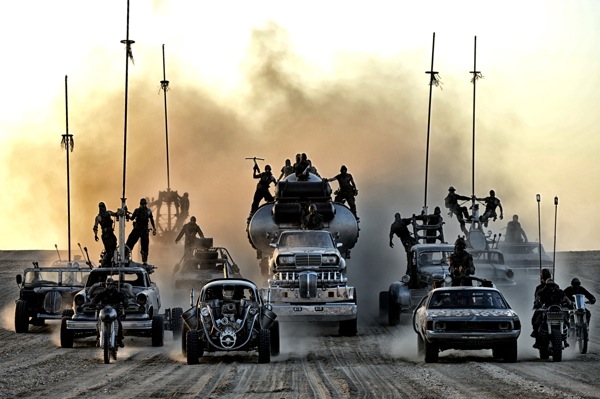
Why was that ride so thrilling?
During the long, brutal winter of ’14-’15 I spent many a night huddled under a blanket watching movies. One of the films viewed was James Cameron’s True Lies, which was made in 1994 and was the last huge action movie that used practical stunts and sets. They really blew up that bridge, and really mounted a harrier jet on a crane so Arnold could clamber over it. Jamie Lee Curtis really jumped onto a helicopter. It cost a lot and wasn’t a huge success, and now these things are all CGI and green screen.
The original Star Wars trilogy and even the Lord of the Rings trilogy used miniatures and guys in suits. The prequels and the Hobbit movies used tons and tons of CGI and in the case of the latter, Peter Jackson even turned Billy Connolly’s Dain into a CGI character. To no good effect. Little kids like the prequels just as well, but most people who like movies find the originals much more engaging and real. The Tolkien stuff is a perfect example of one set of films remaining vital and thrilling while the other is just bleh. Admittedly, one has way better material, but all that animation was ultimately numbing.
It’s obvious that the realness of Mad Max is the main reason people have reacted so strongly to it. Those were real cars, real guys on poles, real deserts, real stunts, real make-up. Of course, there was CGI, but it aided the reality instead of becoming a substitution for it—Charlize Theron’s stump of an arm being a perfect example
I find most contemporary CGI spectacle rubbery and unconvincing. It feels like shopping at the Dollar Tree: drab and monotonous. Of course I’m also old and cranky — younger movie goers, and those used to video game CGI, have no problem with it. But it’s all so lazy. One big or monster can be truly chilling—cf. Stan Winston’s work in The Thing. But that takes real time and care, so an army of CGI Ultrons, or Chitauri or bugs or orcs or whatever swarms the screen with all the spectacle of an iPhone game.
Practical effects are more expensive and take a lot more skill. It’s why its a vanishing art. Mad Max Fury Road is a profoundly 80s movie: it’s touchstones, like the old Mad Max movies, are heavy metal and hot rods and leather jackets. The filmmaking is also 80s standard for stunts and models, with contemporary CGI wizardry thrown in as the seasoning. But the rapturous response to the film made me wonder about the psychological distinction between real and unreal. Yes, we’re back in the Uncanny Valley, the theory that people are attracted to unreal, cartoonish characters but as these characters become more human and realistic, they reach a point where they are actually disturbing and repulsive. Many Robert Zemeckis films are proof of this (Polar Express ho!) We’ve moved a bit beyond Zemeckis’s early efforts, or the now laughably unconvincing swinging Spider-Man of the first Sam Raimi films, now less engaging than the guy in a Godzilla suit of the 50s.
But is there any evidence for this effect beyond constant kvetching about “all that CGI”? I googled “psychological effects of CGI” and found very little easily accessible research. (one of the top results was “Physical, Sexual and Psychological Effects of Male Infant Circumcision: an Exploratory Survey” however.)
Here’s one article from 2011 examining the Uncanny Valley:
In other experiments, MacDorman’s team showed that people feel particularly disconcerted when characters have extremely realistic-looking skin mixed with other traits that are not realistic, such as cartoon eyes. Furthermore, in a 2009 study in which participants were asked to choose the eeriest-looking human face from among a selection, the researchers found that computer-rendered human faces with normal proportions but little detail were rated eeriest. When the faces were extremely detailed, study participants were repulsed by those that were highly disproportionate, with displaced eyes and ears. In short, viewers seemed to want cartoonish facial proportions to match cartoon-level detail, and realistic proportions to match realistic detail. Mismatches are what seemed eerie.
I also found this paper from 2002 (!) about the history of animation in terms of CGI by one David Mitchell. Some solid groundwork there.
A hopeful piece from the BBC in 2013 suggested that special effects might be going practical again, but focused on the budgetary angle. And Cartoon Brew wondered why Practical Effects Get Replaced with CGI? but it’s a video and I don’t have time to watch.
Doubtless, there is a lot of research that studies how humans react to things that are really real and things that seem real…but the time I spent googling didn’t reveal much. I’m sure Mad Max will reignite the debate and this remains a topic for further study.
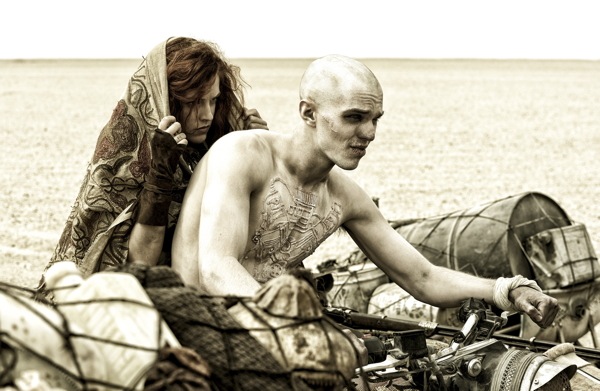
But wasn’t Mad Max Fury Road racist?
The visionary, unsurpassed imagination of artist Brendan McCarthy—co-writer and concept artist—is a huge part of what made MMFR so memorable. Sadly, he’s also been caught making many racist statement in recent years, so it’s hard to praise him without reservations. But yeah, he is awesome as a creator.
But not everyone liked Fury Road. A tumblr user going by Xmaslemmings whose real name I am not smart enough to figure out summed up the racist, ableist, fan-phobic aspects of the film:
Then, like, just look at the fact that they were stoked to work with this guy, that they shot most of this movie in Namibia with an almost exclusively white cast. Look at postapocalyptic fiction of this sort which largely aims to shift the structures of postcolonial Western genre works into a fictive precolonial (or just colonial) state where we can enjoy Cowboys versus No-Longer-Recognizable-As-Indians, open terrain, tribes to fight, lands to claim and to settle. Fury Road, like a lot of these stories, postures as only whiteness speaking to whiteness about whiteness (or substitute for whiteness: a primitive yet “postracial” civilization in which race has inexplicably not been reasserted as a central basis for organizing violent hierarchies of power) but from whom did the filmmakers borrow this imagery of tribal desert life? From whom did these cultures get their spears, their warpaint, their war drums? How have these retained their use as signifiers of barbarism and from where did that significance originate? I think the movie’s answer is: from nowhere. From a mountain with a steering wheel carved into it. As the movie ends with Furiosa ascending to traditional White Saviorhood (most of the only people of color I can recall seeing in the film being in the grateful crowd hailing her as their new queen, or whatever) there’s a quote from “The First History Man” to “sort of jokingly” suggest a universal profundity of the film’s plot and non-ironically underscore that this fantasy is a tabula rasa in which white experience has been miraculously universalized without the need to dismantle white supremacy because the violent establishment of white supremacy did not occur, or something. That isn’t unique to this film. It describes a zillion stories a white author’s ever written in this genre, such as this film, shot in Africa with a mostly white cast, which happens to also have at least one clearly white supremacist voice among its principal originating collaborators.
Lots of fodder for backlash there, and Australia’s own awful history with its native peoples won’t help.
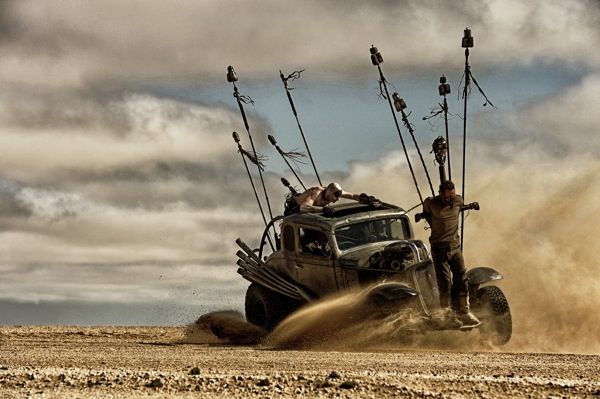
But was it still wonderful?
I hope so. There’s a takedown on MMFR’s feminism at the right wing Breitbart site, but even the critic has to admit it looks great, and the commenters seem to have forgotten the awful feminist agenda because of the great stunts. I think the last movie that pretty much shut up all its critics with its imagination and stunning visuals like this was the original Sin City. I’ll leave this with a quote from Warren Ellis, who has a way with words:
You forget that the MAD MAX films are a narrative continuum, from the brink of societal collapse all the way through to the petrol- and water-cults after the end of the world. Max himself goes from tightly-wound cop to broken man to the Max of FURY ROAD, who, for the first half of the film, is pretty much a grunting animal on his hind legs and then reduced down to a bag of blood. From husband and father to medical object.
Someone said to me the other day that MAD MAX is “his Star Wars.” His modern myth. A myth of the time of steel and petrol, that’s about collapsing back into dark history. Viewed as a continuum, the film cycle almost plays as a warning sent ahead to us from 1980. A time capsule that’s still telling itself stories from inside its box. FURY ROAD doesn’t feel like a modern film. It’s a throwback to classical filmmaking. A scream from the nightmares of the last century.
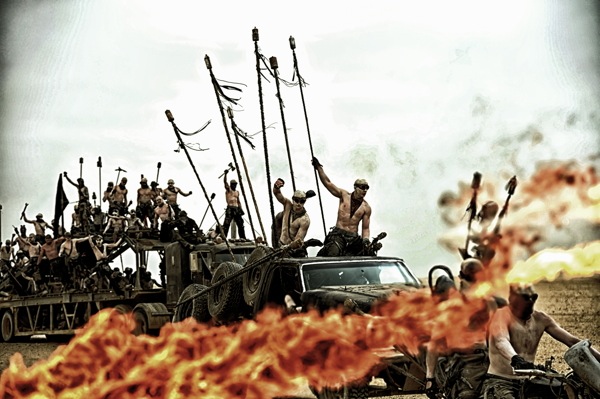
How Much Did The Beat love Mad Max Fury Road?
So much that I spent half an hour on the WB media site downloading the stills just so I can look at them again and again until I go to the theater to see it again.



I suppose when grosses drop like a stone (over next few weeks) people will debate if it’s because of the R-Rating (which I didn’t understand — seemed like PG-13 to me) or the feminist something or other but the truth will really be that this bag of hot air offered no clear characters or conflict + all leveraged on a production design that made no real sense & worst of all, none of this had even a trace of a sense of humor…. In 1979 George Miller made a movie called Mad Max and that was very, very funny.
I agree somewhat with Horatio. I was puzzled by the R rating. And I didn’t think it was nearly as exciting as Mad Max 2. Lots of cool imagery, but it looked more like an excessive heavy metal album.
Great article Heidi! Terrific breakdown of much of the reasons why this was such a visually alluring movie. MMFR reminded me a lot of Drive, particularly in its silence. You had to work hard to hear why people were continuing to struggle despite such a bleak existence, what was pushing them to survive. There were only the smallest nuggets of what kept them going but it worked so much better than those films that rely on an absurd expository scenarios to explain to death their internal struggles. That reinforced the humanist take on this I thought. One on my takeaways from Godbless You Mr. Rosewater by Vonnegut was always the notion that placing expectations on people to be better than their circumstances allow is not only wrong, its cruel. Life at the bottom is hard enough.
I haven’t seen Mad Max the original in a few years, but I do not remember that being a very funny movie. I thought there were quite a few funny moments in Fury Road. When she uses Max as a rifle stand? Most of the audience laughed at that part.
Anywho, can’t wait to see this again.
I thought MMFR was fantastic, superbly entertaining and loaded with awesome action and crash sequences that looked very difficult and expensive to film. I am however taken aback by the backlash it has experienced because of the film’s alleged feminism and the prominent role of Charleze Theron’s Furiosa. I don’t agree with public claims implying MMFR carries a feminist agenda. I agree it empowers the role of women in action films, which is very welcome, but I don’t believe Max was ever upstaged or even fazed out of his starring role by Furiosa. Regardless of how much Furiosa was featured and how many women participated, MMFR is still about the coming of age of Max, who is initially portrayed as a lone survivor reduced to animal instinct by the brutal world he has inhabited after losing his family and humanity in the process. Facing his most perillious circumstance, Max is further reduced (to someone else’s blood bag and a hood ornament), only to discover deep down that he can still care for a cause he became involved with by sheer chance. No matter how many women appear, Max is ultimately the one who saves the day and as in his previous films, he ends up walking alone on his own terms. He could have stayed with Furiosa, much in the same way he could have stayed with the settlers after the truck chase in the Road Warrior. Even in Thunderdome, he chose to stay behind in order to help the rest fly away. Asides from being more “savage” in the beginning, the portrayal of Max in MMFR was no different than the Road Warrior and Thunderdome.
After reading about the proposed sequel’s change of title (from “Furiosa” to “Wasteland”), it seems obvious to me that Warner Bros will green-light a sequel and that Miller has already been advised to make it more about Max, in order to avoid the same kind of anti-feminist backlash MMFR has endured. These movies are still subject to the business model of making money and as absurd as the claims of feminism may be, it’s likley the main reason for the possible sequel’s title change…
Horatio Weisfeld: being wrong is my bidness.
So, since he dressed up a lot of white people with spears and warpaint and make them savage and vicious then he’s a racist and white supremacist. But, if he dressed up a lot of Namibians with spears and warpaint and make them savage and vicious then he’d be a racist and white supremacist for portraying them that way.
The film is racist, and claiming the violence and objectification, which is a mal fantasy is “feminist” because a handful of women fight back, is absurd. And I have never seen a more two dimensional performance as Theron gives as she walks though her part
The new STAR WARS movie uses a lot of practical effects. Everyone over 12 agrees that Lucas went overboard with CGI on the prequels. (In fact, CGI may have been the only reason he wanted to make them.) Excessive CGI is giving everything a cookie-cutter look these days: the Marvel movies, the GODZILLA remake, MAN OF STEEL, etc.
I won’t have time to see FURY ROAD until tomorrow. Can’t wait.
As for PITCH PERFECT 2: maybe it’s time to offer Anna Kendrick a superhero movie. With her in the leading role, not as someone’s sidekick or sister.
What amazes me is how a film with such a long and tortured production can somehow hit the zeitgeist moment so perfectly. It’s complicated, of course, as this great essay (with great linkage) attests to. But I agree — I haven’t been overwhelmed by an action movie like this since Crouching Tiger. Can’t wait til Nicholas Hoult wins an Oscar and sprays his mouth with chrome spray paint during his speech.
Now, can someone please find and post some screenshots of the elder women biker warriors???? And the Seed Keeper? I’m 75 years old and wish there had been a little more about them in the movie. But I’ll settle for a t-shirt with those great old weathered heroic faces. Anyone???
CGI is a cartoon, even when fully rendered.
http://www.cracked.com/blog/6-reasons-expensive-films-end-up-with-crappy-special-effects/
Quiz: For everyone who watched Citizen Kane: Did you notice any of the optical effects?
@Torsten Adair:
For me CGI is not the problem here :
The most annoying thing about Fury Road is to see one of the (once) great directors, a guy who always designed long, elegant extended, deliberate takes, has now decided he worships at the church of shooting his movies as a brain-deadening morass of multi-camera coverage. This makes Fury Road, aside from being a dated heap of Heavy Metal Magazine cliches, down right hard understand much of the time, as to who is doing what to whom. George Miller gives a number of recent interviews boasting about how this one has double the edits of Road Warrior and claiming that’s the style of the day while in fact the last two Academy Award winners, one of them a huge sci-fi block buster, were filmed (seeming) to be one single shot. Even during the talk scenes in Fury Road you can see the camera is constantly SHAKING AROUND the actors because Miller now doesn’t think he needs be bothered to think out how he wants the final edit to play. This is not what I see in any of Miller’s others movies – those films all look as if the director knew exactly how he wanted the scene to unfold visually and could have shot with one camera. I want to see movies directed by George Miller, not movies where Miller guided teams of camera people and editors to finagle a finished film out of some amorphous mess — and I say with sadness: I doubt I will be looking forward to any more movies from George Miller.
“This makes Fury Road, aside from being a dated heap of Heavy Metal Magazine cliches, down right hard understand much of the time, as to who is doing what to whom.”
One of the most frequent comments I’ve heard from people I’ve talked to about the film is how clearly delineated the action is, and how easy it is to understand what’s going on at every moment of the film.
“a view sadly prevalent in the real world, where the existence of a dead male fetus is of more importance than any living female”
Unless you’re talking about the third world and in some cases the second world, that’s a hefty claim to make.
What’s more, I fail to see what the problem is with shooting it in “Namibia with an almost exclusively white cast”. They weren’t planning to be shooting it in Africa until only recently, and in the storyline of the movie it’s still set in outback Australia. You’ll struggle to find many Namibian citizens in outback Australia because of sheer distance, not racism, having American actors is already enough of a strain on suspension of disbelief. That doesn’t make it racist, if anything, including Namibians just to fill a quota seems pretty stupid.
Also, Horatio, did you watch Mad Max? Very little at all about it was funny. Mad Max 2 was funny, Mad Max 3 had humor, Mad Max 1 took itself seriously because it was a world falling apart and a cop trying to do his job in the middle of it and losing his family. It wasn’t funny, it was tragic and grim.
Saw it yesterday and loved it. One of the best action movies ever made, up there with Raiders of the Lost Ark, the original King Kong, and just a few others (including Mad Max 2: The Road Warrior).
The movie has only one real problem, and it’s a big one: the bland and forgettable Tom Hardy. He utterly lacks the movie-star charisma that Mel Gibson brought to the role. Say what you will about Gibson as a person, he knows how to dominate a scene. It looks like Hardy didn’t even try. Or maybe the director didn’t let him.
It’s fitting that Max fades into a crowd at the end, and Furiosa and her “girls” get the last shot. The movie should have been called FURIOSA, because Charlize Theron dominates every scene she appears in. It’s really her story, not Max’s.
KF said: “One of the most frequent comments I’ve heard from people I’ve talked to about the film is how clearly delineated the action is, and how easy it is to understand what’s going on at every moment of the film.”
Yes. After the incoherent action scenes in recent superhero movies, it was refreshing to see a movie filled with complicated action that you could clearly follow.